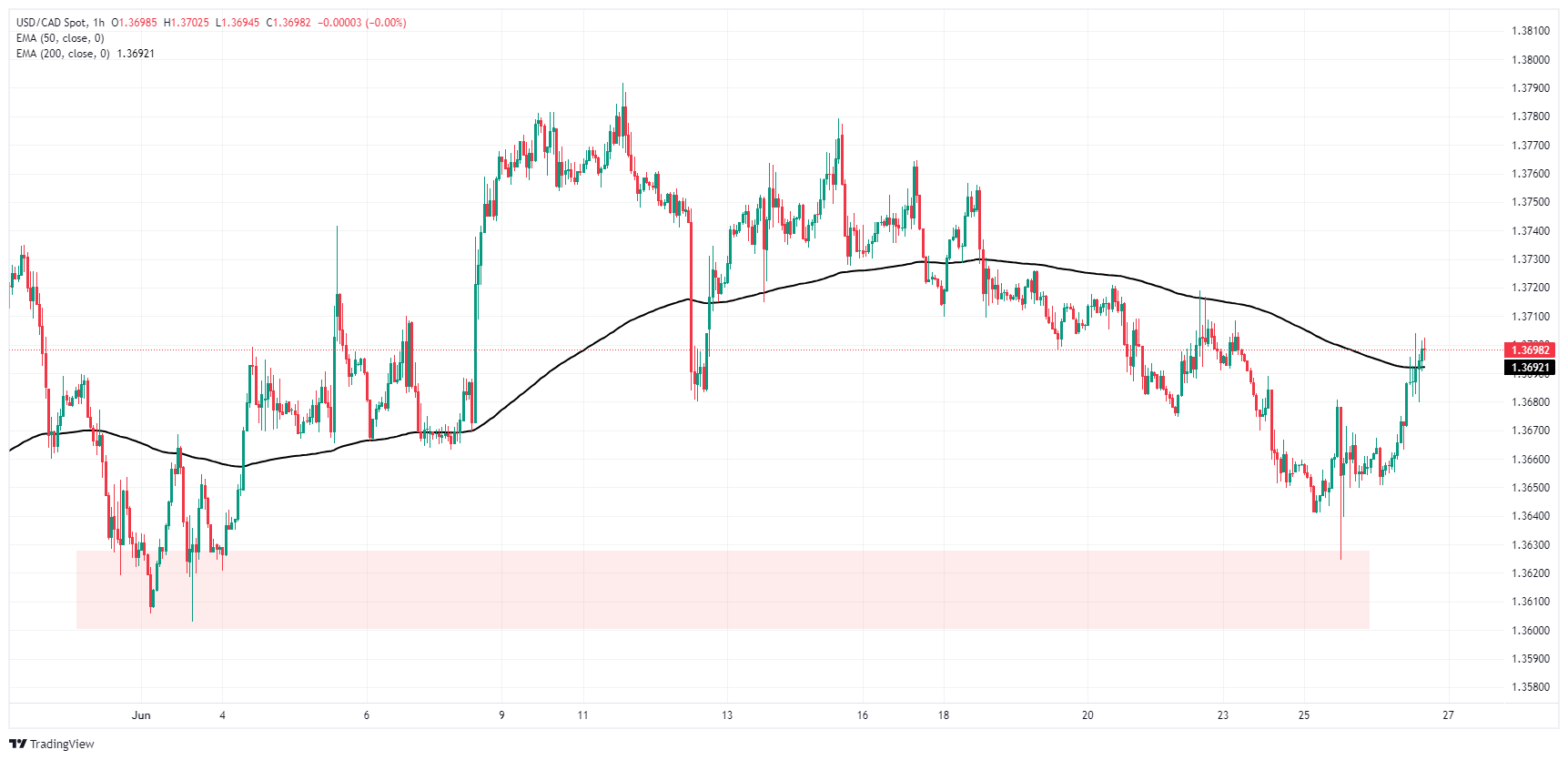- The Canadian Dollar had a mixed performance, weakening against the Dollar.
- Canada reported a possible contraction in wholesale trade in May.
- The Fed’s speeches will continue to dominate the headlines until the release of high-impact data later in the week.
The Canadian Dollar (CAD) is mixed on Wednesday, performing lackluster and trading lower against the US Dollar, as Fed speeches continue to weigh on investors’ focus. Markets expect a series of key economic figures in the second half of the trading week.
US Durable Goods Orders, Initial Jobless Claims and US Gross Domestic Product (GDP) figures are scheduled for Thursday. Canada’s monthly GDP and the US Personal Consumption Expenditure (PCE) Price Index for the month of May will be released on Friday.
Statistics Canada (Statscan) warned of a contraction in wholesale trade activities in May, which follows a moderate increase in April numbers. Statscan’s preliminary estimate is a preview of the final figure that will be published on July 15.
Market Drivers: Canadian Dollar Shakes on Wednesday, Weakens Against Dollar
- Canadian wholesale sales likely contracted 0.9% in May, according to a preliminary estimate from Statscan.
- A decline in upstream business activity will put further pressure on Canada’s upcoming GDP release on Friday, which is forecast to rise 0.3% on a monthly basis in April after 0.0% previously.
- US new home sales in May also declined on Wednesday, settling at -11.3% monthly. This is the sharpest downward correction since July 2022 as real estate activity remains weak.
- Information on the US banking stress test will be released later on Wednesday.
- Markets await the revision of US GDP for the first quarter on Thursday, which is expected to remain stable at 1.3% quarter-on-quarter.
Price of the Canadian Dollar today
The table below shows the percentage change of the Canadian Dollar (CAD) against the major currencies listed today. The Canadian Dollar was the strongest against the Japanese Yen.
| USD | EUR | GBP | CAD | AUD | JPY | NZD | CHF | |
| USD | 0.22% | 0.41% | 0.26% | -0.09% | 0.61% | 0.61% | 0.21% | |
| EUR | -0.22% | 0.19% | 0.04% | -0.31% | 0.41% | 0.40% | 0.00% | |
| GBP | -0.41% | -0.19% | -0.16% | -0.49% | 0.22% | 0.20% | -0.16% | |
| CAD | -0.26% | -0.04% | 0.15% | -0.34% | 0.37% | 0.36% | -0.02% | |
| AUD | 0.09% | 0.30% | 0.48% | 0.34% | 0.71% | 0.71% | 0.35% | |
| JPY | -0.62% | -0.41% | -0.22% | -0.38% | -0.71% | -0.01% | -0.41% | |
| NZD | -0.62% | -0.40% | -0.21% | -0.36% | -0.72% | 0.03% | -0.37% | |
| CHF | -0.24% | -0.02% | 0.17% | 0.02% | -0.32% | 0.39% | 0.39% |
The heat map shows the percentage changes of the major currencies against each other. The base currency is chosen from the left column, while the quote currency is chosen from the top row. For example, if you choose the Euro from the left column and move along the horizontal line to the Japanese Yen, the percentage change shown in the box will represent EUR (base)/JPY (quote).
Technical Analysis: Canadian Dollar Falls Back to 1.3700 Against the Dollar
The Canadian dollar (CAD) was mixed on Wednesday. It rose around four-tenths of a percent against the Japanese yen and the New Zealand dollar. However, it lost a third of a percent against the Australian dollar and fell a quarter of a percent against the US dollar.
USD/CAD rose to the 1.3700 level on Wednesday as the Canadian Dollar retreats against the Greenback. The pair briefly established a multi-week low this week before returning to a familiar congestion zone.
Intraday price action stops at the 200 hourly EMA at 1.3692, and the daily candlesticks have broken a short-term losing streak. The 50-day EMA at 1.3675 provides technical support, and the pair continues to consolidate in a medium-term consolidation pattern above the 200-day EMA at 1.3582.
USD/CAD Hourly Chart
USD/CAD Daily Chart
The Canadian dollar
The key factors that determine the price of the Canadian Dollar (CAD) are the level of interest rates set by the Bank of Canada (BoC), the price of oil, Canada’s main export product, the health of its economy, inflation and the trade balance, which is the difference between the value of Canadian exports and its imports. Other factors are market confidence, that is, whether investors bet on riskier assets (risk-on) or look for safe assets (risk-off), with the risk-on being positive for the CAD. As its largest trading partner, the health of the US economy is also a key factor influencing the Canadian dollar.
The Bank of Canada (BoC) exerts significant influence over the Canadian Dollar by setting the level of interest rates that banks can lend to each other. This influences the level of interest rates for everyone. The BoC’s main objective is to keep inflation between 1% and 3% by adjusting interest rates up or down. Relatively high interest rates are usually positive for the CAD. The Bank of Canada can also use quantitative easing and tightening to influence credit conditions, with the former being negative for the CAD and the latter being positive for the CAD.
The price of oil is a key factor influencing the value of the Canadian Dollar. Oil is Canada’s largest export, so the price of oil tends to have an immediate impact on the value of the CAD. Generally, if the price of oil rises, the CAD also rises, as aggregate demand for the currency increases. The opposite occurs if the price of oil falls. Higher oil prices also tend to lead to a higher probability of a positive trade balance, which also supports the CAD.
Although inflation has traditionally always been considered a negative factor for a currency, as it reduces the value of money, the opposite has actually happened in modern times, with the relaxation of cross-border capital controls. Higher inflation often leads central banks to raise interest rates, attracting more capital inflows from global investors looking for a lucrative place to store their money. This increases the demand for the local currency, which in the case of Canada is the Canadian Dollar.
The published macroeconomic data measures the health of the economy and may have an impact on the Canadian dollar. Indicators such as GDP, manufacturing and services PMIs, employment and consumer confidence surveys can influence the direction of the CAD. A strong economy is good for the Canadian dollar. Not only does it attract more foreign investment, but it may encourage the Bank of Canada to raise interest rates, resulting in a stronger currency. However, if economic data is weak, the CAD is likely to fall.
Source: Fx Street
I am Joshua Winder, a senior-level journalist and editor at World Stock Market. I specialize in covering news related to the stock market and economic trends. With more than 8 years of experience in this field, I have become an expert in financial reporting.






